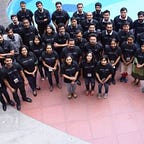#mywaterstory- Ramveer Tanwar
The young engineer who left his high-paying job to restore water bodies around the country, Ramveer Tanwar, also known as the Pond Man, and his team are rehabilitating 12 water bodies at once and have already restored over 40 water bodies around the country. From the very beginning, Mr. Tanwar was passionate about water conservation. He started a campaign during his early graduation days named Jal Chaupal in Uttar Pradesh’s Gautam Budhha Nagar district. He conducted several rallies, made wall paintings, and posters to educate people on the negative impacts of wasting water. Many households would keep their taps open, wasting water for hours at a time. He continued this campaign for three years with his students and encouraged the villagers and family members to reduce the wastage. In an exclusive discussion, he will tell us about his journey and experiences with water.
…
I realized that cleaning drives and public awareness campaigns alone would not be enough to bring about change. Work has to be done from the ground level to bring about change. After graduation, while I was working, I simultaneously started approaching corporate entities and village heads to get their support and assistance in restoring water bodies. After 5–6 months of launching my initiative, I received support from a small corporate group. They claimed they would support us with recommendations and expand our initiative provided the project is completed at a low cost. The first pond to get restored was in Dabra village; it was a successful restoration attempt, and we instantly got recognized by media sources, corporations, government officials, and others. After this, I left my job at MNC, and I committed myself to restore water bodies. The initiative which started with a pond has now spread to several water bodies across the country.
When it comes to pond restoration, it’s crucial to identify the pond and the problem that exists there, such as water hyacinth, village encroachment, waste fill-up, or ponds getting dried up as their water lines are disconnected. Once the problem gets identified, we use a 3-pit system to solve it. The pond is partitioned into 2–3 small sections in the 3-pit system approach. The water hyacinth or garbage is removed manually in the first section, then desilted, and finally, a treatment system is installed at the pond’s inlet where the greywater enters. Freshly treated water enters the pond because of our approach, and that is how we restore the ponds. We also build a pathway around the pond, build benches, and plant trees so that the locals can enjoy themselves.
#Selfiewithpond was a social media campaign that was started with the intent of identifying youths across the country supporting the idea of restoring water bodies. The campaign created a huge impact, and we got support from around 10,000 youngsters. Although our initiative has received positive reviews, the biggest challenge to date has been the encroachment of these water bodies. Residents are hesitant to allow the water bodies to be cleaned or restored as they believe that doing so will lead to officials evicting them from their houses. Also, our projects are funded through CSR but getting financed for restoring water bodies in rural areas remains a struggle. Maintaining the recovered water bodies is also a challenge because they fill up with garbage again after 2–3 years. To avoid this, we’ve begun to link the ponds with local livelihood options such as aquaculture, fish farming, and lotus farming.
On a personal note, the moment I see the before and after photographs of the same water body, it motivates me to keep going forward. It pleases me greatly to see the residents’ faces light up when they witness the improved condition of their water body, which they had feared could not be restored.
